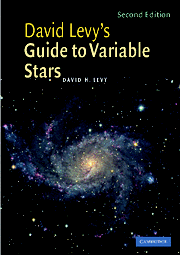Book contents
- Frontmatter
- Contents
- Foreword to the first edition
- Preface
- Acknowledgments
- Part I Getting to know the sky
- Part II Getting to know the variables
- 5 Meeting the family
- 6 Getting started with Cepheids
- 7 Algol, the demon of autumn
- 8 How to estimate a variable
- 9 Names and records
- 10 How your observations help us understand a variable star
- 11 Observing hints
- 12 Observing with CCDs
- 13 Stately and wonderful
- 14 Stars of challenge
- 15 Bright, easy, and interesting
- 16 Betelgeuse: easy and hard
- 17 Not too regular
- 18 Nova? What nova?
- 19 Supernovae
- 20 Clyde Tombaugh's star and the family of cataclysmic variables
- 21 A nova in reverse?
- 22 RU Lupi?
- 23 Orion, the star factory
- 24 Other variable things
- 25 The Sun
- Part III Suggested variables for observation throughout the year
- Part IV A miscellany
- Index
12 - Observing with CCDs
from Part II - Getting to know the variables
Published online by Cambridge University Press: 05 August 2012
- Frontmatter
- Contents
- Foreword to the first edition
- Preface
- Acknowledgments
- Part I Getting to know the sky
- Part II Getting to know the variables
- 5 Meeting the family
- 6 Getting started with Cepheids
- 7 Algol, the demon of autumn
- 8 How to estimate a variable
- 9 Names and records
- 10 How your observations help us understand a variable star
- 11 Observing hints
- 12 Observing with CCDs
- 13 Stately and wonderful
- 14 Stars of challenge
- 15 Bright, easy, and interesting
- 16 Betelgeuse: easy and hard
- 17 Not too regular
- 18 Nova? What nova?
- 19 Supernovae
- 20 Clyde Tombaugh's star and the family of cataclysmic variables
- 21 A nova in reverse?
- 22 RU Lupi?
- 23 Orion, the star factory
- 24 Other variable things
- 25 The Sun
- Part III Suggested variables for observation throughout the year
- Part IV A miscellany
- Index
Summary
When the first edition of this book appeared in 1989, it offered no advice on observing with CCDs. Although CCD systems were available at the time to the professional community, they were very expensive, costing upwards of 70 000 US dollars. Today, CCDs are well within the reach of advanced amateur astronomers. A top-of-the-line system, the SBIG Research STL-11000M/CM, retails for about a sixth of that price, and it is far more capable than anything that was available in the 1980s.
With a CCD camera, your experience with variable stars will enter a whole new dimension. I realized this on a warm April night in 2004 when, as part of the spring meeting of the AAVSO, Wendee and I sponsored an evening observing session. I can't remember ever having so much fun. Two of the observers, including Tom Cragg visiting from Australia, were interested in checking on the state of T Pyxidis, one of their favorite recurrent novae. However, being pretty low in the southwest, the star was impossible to see visually with any of the available telescopes that evening.
Just a year earlier, our attempt to study T Pyx would have ended there. But on that night we used only a 15 cm reflector plus a Meade 416 CCD, and found the field a few degrees above the southwest horizon. Being thoroughly familiar with the field, Cragg had no trouble finding T Pyxidis and estimating its magnitude as 17.3! It was easy, productive, and fun.
- Type
- Chapter
- Information
- David Levy's Guide to Variable Stars , pp. 59 - 67Publisher: Cambridge University PressPrint publication year: 2005

